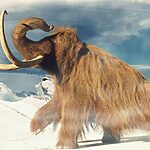Curly-haired animals are more than just adorable; they’re a marvel of genetics and a testament to nature’s diversity. From the plush Selkirk Rex Cat to the woolly Mangalica Pig, these creatures captivate us with their unique coats and endearing qualities.
Whether you’re an animal lover, a pet owner facing grooming challenges, or simply intrigued by the unusual, this article offers a treasure trove of insights into the world of animals with curly hair.
Key Takeaways:
- The Selkirk Rex Cat, originating from a spontaneous mutation in Montana in 1987, is known for its plush, curly coat and friendly temperament, making it a popular pet and show cat, though it requires regular grooming and may be prone to certain health issues.
- Poodles, originally bred as water retrievers, are distinguished by their hypoallergenic curly coats and come in three sizes (Standard, Miniature, and Toy), requiring regular grooming; they are intelligent and excel in agility and as therapy dogs but can have breed-specific health concerns.
- The Mangalica Pig from Hungary, with its thick, curly hair resembling a sheep’s fleece, is valued for its flavorful meat and is a symbol of sustainable agriculture, though it has become rarer, prompting conservation efforts to preserve this heritage breed.
- The Curly-Coated Retriever, one of the oldest retriever breeds with tight, water-resistant curls, is robust, intelligent, and requires regular exercise and grooming; it is well-suited for active families but may be susceptible to genetic health conditions.
- The Lincoln Sheep, with its long, curly wool, is one of the oldest and most visually striking sheep breeds, contributing significantly to the wool industry and sustainable agriculture, though it requires careful fleece maintenance and faces market challenges.
List of Animals With Curly Hair
Selkirk Rex cats, Poodles, Mangalica pigs, Curly-Coated Retrievers, Lincoln Sheep, Bichon Frises, American Bashkir Curly Horses, Angora Rabbits, Hungarian Pumis, Alpacas, Angora Goats, Frillback Pigeons, and Sebastopol Geese all have curly hair.
| Animal | Distinctive Traits | Origin/Habitat | Special Notes |
| Selkirk Rex Cat | Plush, curly coat, large, round eyes | Montana, USA | Requires regular grooming, prone to certain health issues |
| Poodle | Hypoallergenic curly coat, intelligent | Germany | Requires regular grooming, excels in agility, may have breed-specific health concerns |
| Mangalica Pig | Thick, curly hair resembling a sheep’s fleece | Hungary | Valued for its meat, symbol of sustainable agriculture, rarer breed |
| Curly-Coated Retriever | Tight, water-resistant curls, robust | England | Requires regular exercise and grooming, prone to genetic health conditions |
| Lincoln Sheep | Long, curly wool, visually striking | England | Contributes to wool industry, requires fleece maintenance, faces market challenges |
| Bichon Frise | Plush, white curly coat, playful and affectionate | Mediterranean region | Requires regular grooming, prone to allergies and dental issues |
| American Bashkir Curly Horse | Curly coat, hypoallergenic, gentle and friendly | North America | Used in various equestrian disciplines, conservation efforts in place |
| Angora Rabbit | Long, soft, naturally curly fur | Ankara, Turkey | Used in textile industry, requires regular grooming, prone to wool block |
| Hungarian Pumi | Curly coat, spirited demeanor, sharp mind | Hungary | Requires regular grooming, excels in dog sports and agility competitions |
| Alpaca | Luxurious fleece, gentle temperament | Andes Mountains, South America | Valued in high-end fashion and artisanal crafts, eco-friendly farming aspect |
| Angora Goat | Luscious, curly fleece known as mohair | Ankara, Turkey | Valued in textile industry, adaptable to various farming environments |
| Frillback Pigeon | Curly feathers on wing shields, ornate appearance | Developed through selective breeding | Popular in fancy pigeon competitions, requires specific care for feathers |
| Sebastopol Goose | Long, spiraling feathers, elegant appearance | Central Europe | Used historically for luxurious bedding and garments, calm and sociable temperament |
1. Selkirk Rex Cat
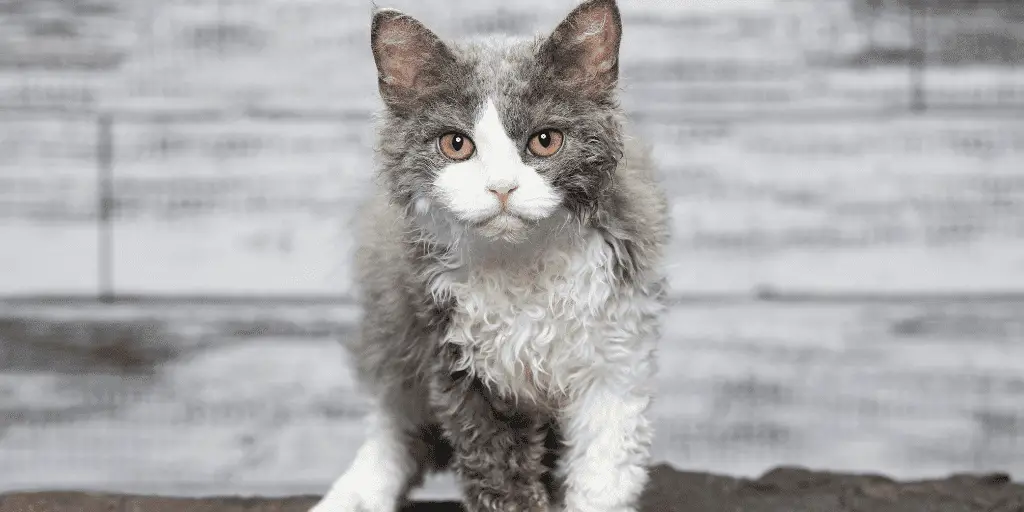
The Selkirk Rex Cat, with its distinctive curly fur, is a breed that stands out in the feline world. This breed’s history began with a happy accident in 1987 when a housecat in Montana gave birth to a litter that included a kitten with unusually curly hair.
This kitten, named Miss DePesto, was the result of a spontaneous mutation, and her unique coat became the cornerstone of the Selkirk Rex breed. Breeders took an interest, and through careful breeding, the Selkirk Rex’s curly coat was established as a dominant genetic trait.
Physically, the Selkirk Rex is a medium to large cat with a sturdy build. The fur, which can come in a variety of colors and patterns, is plush and woolly, with loose, unstructured curls that give the breed a teddy bear-like appearance. One of the most distinguishing features of the Selkirk Rex is its large, round eyes that give it an endearing expression.
When it comes to temperament, the Selkirk Rex is known for being patient, loving, and tolerant, making it an excellent companion. They are often described as playful and relaxed, fitting well into families and various living situations. Their sociable nature means they tend to get along with children and other pets.
Grooming a Selkirk Rex requires a bit more attention than your average cat due to their curly coat. Regular brushing is necessary to prevent matting and to maintain the coat’s texture. It’s also important to be aware of common health issues, such as polycystic kidney disease and hypertrophic cardiomyopathy, which the breed can be predisposed to.
The Selkirk Rex has gained popularity not only as a pet but also in the show ring. Their unique look and charming personality have earned them a special place in the hearts of cat enthusiasts around the world.
2. Poodle
The Poodle, with its distinctive curly locks, is not just a pretty face; it’s a breed steeped in history and versatility. Originally bred as a water retriever, the Poodle’s journey from the lakes of Germany to the hearts of families worldwide is a fascinating tale of evolution. Over time, this breed has been refined and diversified into the three sizes we recognize today: Standard, Miniature, and Toy.
Each size category was developed to serve different purposes and lifestyles, yet all retain the hallmark curly coat that Poodles are famous for. This isn’t just for show; their unique fur serves as a protective layer and is hypoallergenic, making them a great choice for those with allergies.
However, beauty comes with a price, and the Poodle’s coat requires regular grooming to prevent matting and maintain its shape. From the stylish ‘pompons’ to the practical ‘sporting clip’, grooming styles vary widely, reflecting both the dog’s needs and the owner’s preferences.
Beyond their looks, Poodles are renowned for their sharp minds and eagerness to please, making them stars in dog shows and agility sports. Their intelligence also makes them excellent therapy animals, providing comfort and support to those in need.
However, prospective owners should be aware of health issues such as hip dysplasia and eye disorders, which can be mitigated through responsible breeding practices.
3. Mangalica Pig
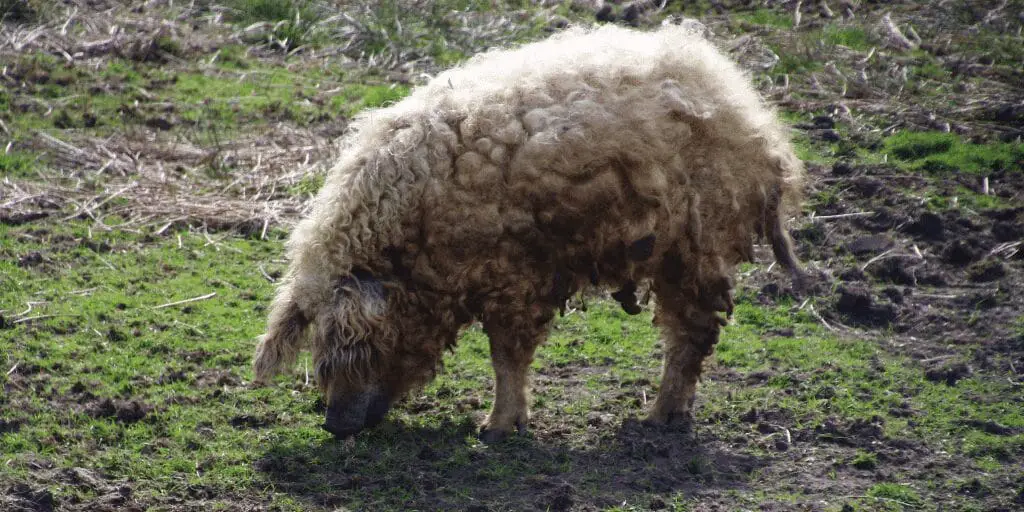
Dive into the world of the Mangalica Pig, a breed known for its woolly, curly hair. Start with the breed’s historical background, detailing its origin and historical significance in Hungary.
Describe the physical characteristics that set the Mangalica apart from other pig breeds, particularly focusing on its curly coat. Discuss the breed’s temperament, lifestyle, and how it has become a symbol of artisanal farming and sustainable agriculture.
Highlight the culinary value of the Mangalica, touching on its resurgence in gourmet food circles. Conclude with current conservation efforts and the breed’s status in modern farming.
The Mangalica Pig, often affectionately referred to as a ‘sheep-pig’ due to its unique fleece, is a heritage breed that hails from Hungary. This curly-haired wonder first trotted onto the scene in the early 19th century and quickly became a staple in Hungarian agriculture due to its hardy nature and the high-quality fat it produced.
Unlike the sleek coats of their porcine cousins, Mangalicas are cloaked in thick, curly hair that makes them well-suited to the harsh winters of their homeland.
Their physical charm is more than just skin deep. The Mangalica’s coat, which can range from light blonde to a deep, rusty red, is a testament to their distinctiveness.
But it’s not just their appearance that’s won hearts; these pigs have a docile temperament, making them a favorite among artisanal farmers who value animal welfare and traditional farming practices. The Mangalica has become a symbol of sustainable agriculture, thriving in free-range environments where they can forage and roam, which in turn supports biodiversity.
Culinary connoisseurs have also rediscovered the Mangalica, celebrating its rich, flavorful meat and marbled fat that’s perfect for charcuterie, earning it a place at the high table of gourmet food. As a result, the breed has seen a renaissance in the culinary world, with chefs and foodies alike seeking out its superior taste and texture.
Despite their popularity, Mangalicas are not as common as they once were, leading to concerted conservation efforts. These initiatives aim to preserve the breed not only for its agricultural and gastronomic value but also as a living piece of Hungarian heritage.
4. Curly-Coated Retriever
The Curly-Coated Retriever stands out in the canine world with its distinctive, tight curls that cover its body. This breed has a rich history that dates back to early 19th-century England, where it was developed primarily to retrieve waterfowl for hunters.
The breed’s lineage is believed to include the now-extinct English Water Spaniel, the Poodle, and the Irish Water Spaniel, which contributed to its unique coat and adept swimming abilities.
Physically, the Curly-Coated Retriever is a robust and agile dog, with a coat that is not only curly but also water-resistant, making it an excellent swimmer. The curls are small, tight, and cover the entire body except for the face and front of the legs.
The coat comes in two solid colors: black and liver. Grooming needs are relatively low compared to other breeds with long hair, as the coat naturally repels dirt and debris. However, occasional brushing is necessary to remove dead hair and maintain the coat’s condition.
In terms of temperament, the Curly-Coated Retriever is known for its intelligence and independence. It is a breed that thrives with an active family or individual, as it possesses a high level of energy and requires regular exercise. Training should be consistent and positive, as the breed is sensitive to harsh methods. They are generally healthy dogs, but like many breeds, they can be prone to certain genetic conditions, such as hip dysplasia and eye disorders.
5. Lincoln Sheep
The Lincoln Sheep, a breed with a storied past, is a true gem of the wool industry. Originating from England, this breed has been around since the Middle Ages, making a name for itself with its long, lustrous, and unmistakably curly wool. The breed’s historical significance is deeply intertwined with the development of the wool trade, a key economic driver of the past.
Physically, the Lincoln Sheep is quite the spectacle. It boasts one of the heaviest and longest fleeces among sheep breeds, with locks that can grow up to 12 inches in length. The wool is not only curly but also incredibly shiny, giving it a distinctive look that’s hard to miss. Typically, the fleece comes in shades of white, but you can also find Lincolns with beautiful natural-colored fleeces.
When it comes to temperament, these sheep are known for being docile and manageable, making them a favorite among shepherds. Their husbandry requirements are straightforward, but they do need ample space to graze and a keen eye on their fleece, which requires regular maintenance to prevent matting and ensure high-quality wool.
In modern farming, the Lincoln Sheep continues to play a role, particularly in sustainable agriculture practices. Their ability to graze and manage land naturally makes them an asset to eco-friendly farming operations.
The breed’s economic and cultural importance cannot be overstated, especially in wool production and the craft industry. The Lincoln’s wool is a staple in creating luxurious garments and intricate handspun crafts, contributing to local economies and artisanal traditions.
As for current trends, there’s a growing interest in the breed among small-scale farmers and hobbyists who appreciate the Lincoln’s contributions to biodiversity and heritage breeding. However, challenges such as market fluctuations and competition from synthetic fibers pose ongoing concerns for those dedicated to preserving this magnificent breed.
6. Bichon Frise
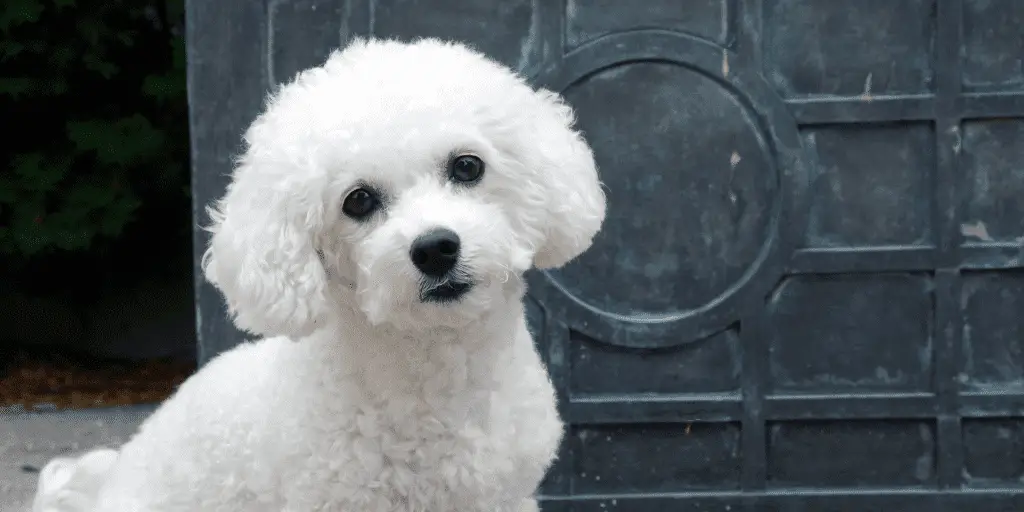
The Bichon Frise, with its cloud-like, curly coat, is a small dog breed that exudes charm and cheerfulness. Originating from the Mediterranean region, this breed has a storied history, having been favored by royalty and commoners alike through the centuries.
Its popularity soared as it became known for its role as a companion dog, particularly in France during the Renaissance. The Bichon Frise’s physical characteristics are undeniably distinctive, with a plush, white coat that is both soft and springy to the touch. This breed’s coat is a defining feature, requiring regular grooming to maintain its characteristic puffball appearance.
In terms of temperament, the Bichon Frise is known for its playful and affectionate nature, making it an excellent addition to any family. Their friendly demeanor and adaptability have earned them a spot in the hearts of many pet owners. However, prospective owners should be aware of the breed’s common health concerns, such as allergies and dental issues, which underscore the importance of regular grooming and care.
The Bichon Frise has also made its mark in popular culture and dog shows, often stealing the spotlight with its vivacious personality and perfectly coiffed appearance. Their showmanship and poise in the ring reflect the breed’s long-standing association with nobility and the arts.
7. American Bashkir Curly Horse
The American Bashkir Curly Horse is a breed that captures the imagination with its distinctive, spiraled locks. This breed’s origins are shrouded in mystery, with stories of their presence in historical paintings and Native American folklore adding to their allure.
The American Bashkir Curly Horse is not only known for its unique coat but also for its historical significance, having been recognized by indigenous cultures and early American settlers for its hardiness and versatility.
Physically, these horses are a sight to behold, with a range of curls that can be tight ringlets to looser waves. Intriguingly, their coat changes with the seasons, becoming thicker and curlier in the winter, while some may even become nearly straight-haired in the summer. Each horse’s curls are as individual as a fingerprint, adding to the breed’s charm.
The temperament of the American Bashkir Curly Horse is as warm as its coat is curly. Known for their gentle and friendly disposition, they make excellent companions for riders of all ages. Their versatility shines through in various equestrian disciplines, making them a favorite among horse enthusiasts.
One of the most remarkable features of the American Bashkir Curly Horse is its hypoallergenic coat, which allows people who are typically allergic to horses to enjoy riding and caring for these animals. This has made them a beacon of hope for allergy sufferers who long for equine companionship.
As for their current status, the American Bashkir Curly Horse is cherished within equestrian communities, with conservation efforts in place to preserve this unique breed. Their popularity continues to grow as more people discover the joy and benefits of interacting with these curly-coated equines.
8. Angora Rabbit
The Angora Rabbit is a distinctive breed, celebrated for its long, soft, and naturally curly fur. Originating from Ankara, Turkey, these rabbits have a rich history, having been a staple in the textile industry for centuries. Their wool was once so revered that it was reserved for royalty, and it continues to be a luxurious material in the crafting world.
There are several types of Angora Rabbits, each with unique fur characteristics. The French Angora is known for its dense, silky wool and a lack of facial furnishings, giving it a more streamlined appearance.
The English Angora, on the other hand, is covered in fur from its rounded ears to its feet, resembling a fluffy ball. The Giant Angora is the largest, with a wool production to match its size, and it requires considerable grooming.
These rabbits are more than just wool producers; they have a gentle and friendly temperament, making them excellent companions. They thrive on social interaction and can form strong bonds with their human caretakers. However, their long fur demands regular grooming to prevent matting and wool block, a common health concern where ingested fur can cause digestive issues.
In modern times, Angora Rabbits are not only found on small-scale farms for their wool but are also cherished as pets. Their endearing personalities and unique appearance continue to capture the hearts of many.
9. Hungarian Pumi
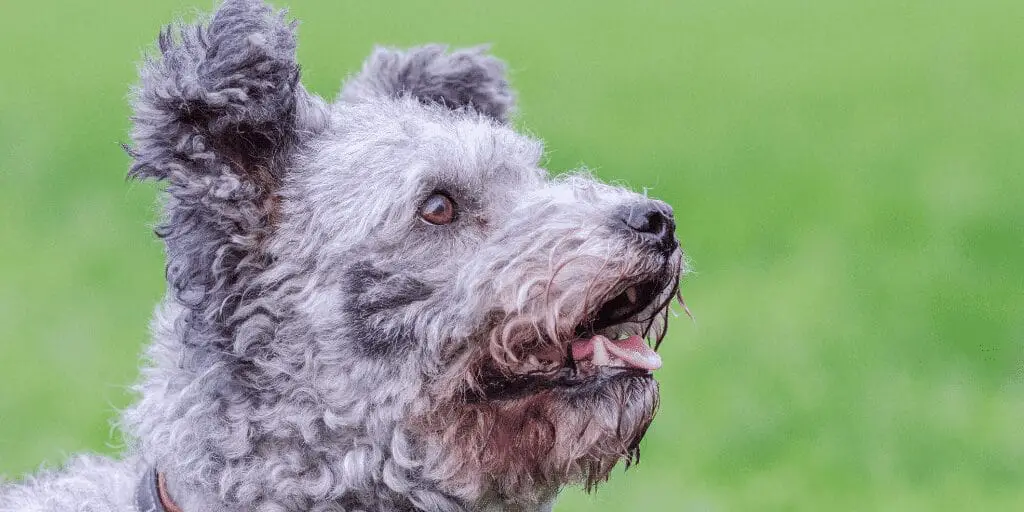
The Hungarian Pumi, with its distinctive curly coat and spirited demeanor, has a rich history rooted in the pastoral landscapes of Hungary. Originally bred as a sheepdog, this breed has shown remarkable versatility, transitioning seamlessly into the role of a general farm dog.
The Pumi’s physical characteristics are quite unique, with a coat that curls tightly, giving it a teddy bear-like appearance. This is complemented by their erect ears, which stand tall and alert, and an expressive face that seems to reflect a keen intelligence.
Speaking of intelligence, the Pumi is known for its sharp mind and boundless energy, making it an excellent candidate for a variety of dog sports and activities. Their temperament is a blend of eagerness and curiosity, which means they thrive in environments where they can engage both their bodies and minds.
As for grooming, those curls do require regular attention to keep the coat free of mats and tangles. Health-wise, the Pumi is generally robust, but like all breeds, they have certain conditions to which they may be predisposed.
As the Pumi’s reputation has spread beyond the borders of Hungary, their participation in dog shows and agility competitions has been on the rise. They’re not just a pretty face; their agility and responsiveness have earned them accolades in various canine sports.
10. Alpacas
Alpacas are truly fascinating creatures, especially when you delve into their world, starting with their origins in the majestic Andes Mountains. These animals were not only domesticated by ancient civilizations for their utility but also cherished for their unique and luxurious fleece.
The physical characteristics of alpacas are many, but it’s their fleece that really sets them apart. With a quality that rivals the finest textiles, alpaca fleece comes in an array of natural colors, from the purest whites and creams to rich browns and even blacks. The texture? Imagine the softest, most huggable material, and you’re close to understanding the allure of alpaca fleece.
Beyond their fleece, alpacas are known for their gentle temperament, making them excellent companions on farms. They have a complex social structure that is fascinating to observe and are surprisingly adaptable to various climates, thriving in conditions ranging from the high altitudes of South America to the more temperate regions of North America and beyond.
The economic and cultural significance of alpaca fleece in the textile industry cannot be overstated. It’s a material that’s not only sought after in high-end fashion but also treasured in artisanal crafts, reflecting a deep heritage and ongoing tradition.
The popularity of alpacas as farm animals and pets is on the rise, and with good reason. They bring a sustainable and eco-friendly aspect to farming that is increasingly valued in today’s world. Their curly fleece is not just a product but a story of heritage, luxury, and sustainability.
11. Angora Goats
Angora Goats are a fascinating breed, with a history as rich and luxurious as the mohair they produce. Originating from the Ankara region in Turkey, these goats have been prized for their fiber for centuries. Their journey from the Turkish highlands to farms and fashion houses across the globe is a testament to the enduring allure of their curly coats.
Physically, Angora Goats are quite distinctive. They boast a luscious, curly fleece known as mohair, which can grow in a variety of colors, from pure white to deep charcoal. The texture of their mohair is silky and naturally lustrous, with individual fibers often reaching impressive lengths before shearing. This unique coat not only makes them stand out in the animal kingdom but also has a practical side, offering protection from harsh weather conditions.
When it comes to temperament, these goats are generally docile and responsive to human interaction, making them a favorite among farmers. Their husbandry requirements, while specific, are manageable with proper knowledge and resources. Angora Goats can adapt to a range of farming environments, but they do best with ample space to graze and a climate that doesn’t get too wet or muddy, as this can damage their precious fleece.
The economic significance of mohair cannot be overstated. In the textile industry, it’s a sought-after material, revered for its durability and the luxurious feel it lends to garments and home textiles.
However, modern Angora Goat farming faces its own set of challenges and opportunities. As the world moves towards more sustainable practices, farmers and producers are finding innovative ways to ensure the welfare of these animals while maintaining the high-quality standards that mohair demands.
12. Frillback Pigeons
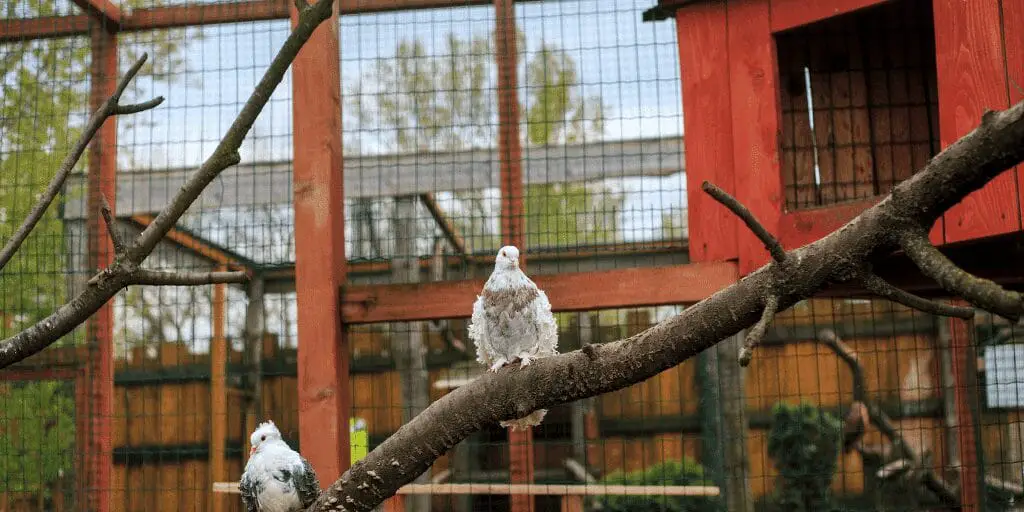
Dive into the unique world of Frillback Pigeons, known for their ornate curly feathers. This breed’s development is a testament to the art of selective breeding, where aesthetics play a central role. Frillback Pigeons are a sight to behold, with their most striking feature being the curls or frills on their wing shields, which are akin to delicate spirals. These feathers have a distinct texture that sets them apart from other pigeon breeds.
The physical characteristics of Frillback Pigeons are not limited to their curly feathers. They come in a variety of color variations, including blue, black, red, and white, each adding to the breed’s visual appeal. Their unique feathering extends to the crest of their head, giving them an almost regal appearance.
When it comes to temperament, Frillback Pigeons are known for their gentle and calm nature, making them a favorite among pigeon enthusiasts. They exhibit a friendly behavior, which, coupled with their unique looks, makes them highly suitable for those interested in ornamental birds.
The breed’s popularity soars in fancy pigeon competitions, where their unique features are celebrated. The community of breeders and enthusiasts is vibrant and supportive, often gathering at shows to admire each other’s birds and exchange tips on care and breeding.
To maintain the health and appearance of Frillback Pigeons, specific husbandry practices are essential. This includes a balanced diet, regular health check-ups, and a clean environment to prevent feather damage. The care for these birds is as unique as their curls, requiring attention to detail to ensure they look their best.
13. Sebastopol Geese
Originating from the chilly climes of Central Europe, Sebastopol Geese are a sight to behold with their long, spiraling feathers that seem to dance with the wind.
These birds have a storied history, having been bred not just for their striking appearance but also for their feathers, which were once a coveted resource in the production of luxurious bedding and garments. The breed’s development was no accident; it was a careful orchestration of selective breeding practices aimed at enhancing the unique characteristics of their plumage.
Physically, Sebastopol Geese are distinguished by their feather structure. Unlike the smooth, flat feathers of their waterfowl kin, these geese sport a mane of white, curly feathers that cover their bodies, giving them an almost baroque elegance.
The feathers can come in various color variations, from the classic snowy white to shades of gray and even buff. Beyond their ornamental feathers, these geese are known for their calm and sociable temperament, making them a favorite among waterfowl enthusiasts.
They adapt well to different farm environments, though they do have specific needs, such as protection from harsh weather due to their less water-resistant feathers.
One of the challenges in raising Sebastopol Geese is their limited ability to fly, a trade-off for their luxurious locks. Caretakers must provide adequate space and protection since their flight impairment makes them more vulnerable to predators. Despite these challenges, the breed has a dedicated following and plays a role in sustainable farming practices, with a focus on ethical breeding and conservation.
- What Should I Do If A Koala Bites Me? Safety Guide - 2024-05-30
- Are Kangaroos Born Without Hind Legs? A Fascinating Journey - 2024-05-30
- Animals That Look Like Squirrels - 2024-05-30



